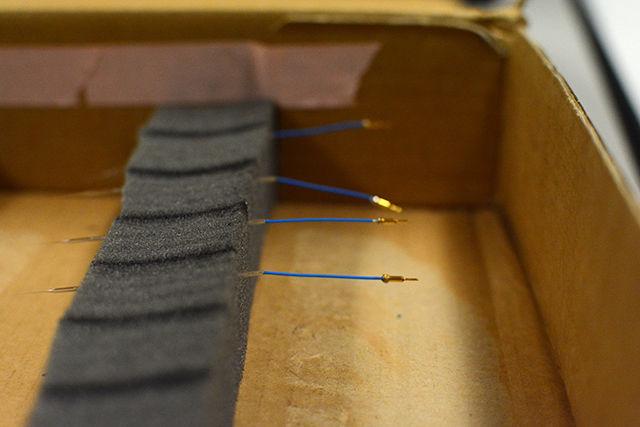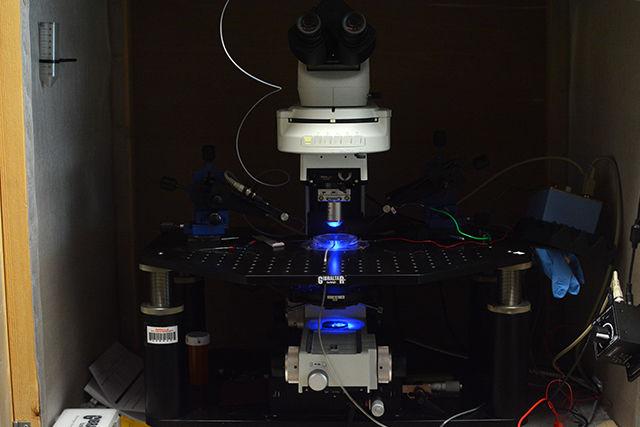Drug addiction not only affects one’s life also alters a person’s personality in concrete, biological ways. In Sombers Lab at NC State, researchers study these neurochemical changes in the brain and develop the tools needed to make complex measurements.
Leslie Sombers, an associate professor of analytical chemistry, discusses the lab’s work.
“It’s very interdisciplinary, because we target a problem, a problem that spans multiple disciplines in and of itself, and in order to solve that problem we need to build the tools — the equipment, the software, the hardware,” Sombers said. “Most of it we can’t just order from a vendor, so we have to work across disciplines to make those tools happen and we have to work together with people with a background in behavioral science to apply them to understand how specific chemical fluctuations in the brain are contributing to both normal aspects of motivated behavior and abnormal aspects that develop in situations such as with substance abuse.”
The interdisciplinary efforts of the lab members have helped to make advances in microelectrode technology, which is used to gather the data that represent the implications and effects of addiction.
“The research that’s happening in this lab is cutting-edge research and we need help from across the spectrum of science,” said Greg McCarty, a research associate professor of analytical chemistry. “I’m an engineer and a chemist. I was trained as an analytical physical chemist so I can develop technological things, so I go through and a lot of the technologies we are developing, we’re pioneering these technologies so they need equipment put together, they need the protocols worked out and so there is a lot of that kind of [interdisciplinary work].”
Understanding more about how addiction works specifically in the brain and learning about what addiction really is could help create better therapies for people with drug addiction.
“Everybody sitting here has the common sense to understand that drug addiction and substance abuse is a disease, it’s a health problem,” said Xiaohu Xie, a research assistant professor of chemistry. “Because of that, based on this, you start doing all this research trying to understand what it is and how to find therapy to treat people. You can throw all this politics and religion into this field but you have to understand that drug addiction is a health problem.”
There is also a genetic predisposition that makes some people more vulnerable to becoming drug addicts after they start taking the drugs, according to Xie.
“Drug addiction is a prolonged neurological change, because you take the drug repeatedly,” Xie said. “The drug itself changes the brain structure, the brain function and causes the personality change and the behavior change. We understand that even when you stop taking the drug, because the change persists for a long time you’re going to have a relapse problem, you’re going to have a seeking problem.”
To find out why some people are more vulnerable to becoming addicted to drugs, the team uses a decision making model. People who are highly impulsive have been found to be more likely to have a drug addiction, and the model helps figure out whether that is because the individual was highly impulsive beforehand or because they became that way after taking the drugs, according to Xie.
The lab can control variables and use various behavior models to measure concrete data related to each aspect of addiction, whether that be the factor of impulsiveness or environmental cues.
“We pair that model with electrochemical measurements of how specific chemical species, in this case dopamine, is fluctuating time locked with the observed behaviors,” Sombers said. “So the idea here is to correlate the molecular measurements using the electrochemistry with the behaviors so we can understand how those neurochemicals are driving specific aspects of that behavior.”
The lab crafts electrodes that are about one-tenth the size of a human hair to take electrochemical measurements in real time. These electrodes look like very fine fibers, and I am shown the tip of an electrode under a microscope in the lab.
“Right now what is exposed into the lens is the tip of our electrodes, and so the very very tip of that is actually the carbon fiber that you just saw and is manually cut by our lab members to 100 micrometers,” said Samantha Smith, a graduate student studying chemistry.
This technology allows the team to measure changes in neurochemicals in real time.
“The brain changes in many ways and we can make measurements of that that are solid, definitive measurements of how these chemical species are changing with the addiction process using our model,” Sombers said.
Altering addictive behaviors can be challenging because of the changes in brain structure and function.
“The drug itself changes your brain, the function, essentially overlapping with your normal functions like — you’re taking the food, you do whatever, reinforcing things you want to do but that brain function is hijacked by the drug,” Xie said. “To precisely control the risk behaviors associated with drug addiction, you have to precisely understand what is going on during the behavior.”
Learning about the specific mechanisms contributing to the progression of addiction could help to inform better therapeutic strategies, according to Sombers.
Some of the substances that the lab studies include cocaine, nicotine, neuropeptides and opioid peptides.
“In this lab we monitor a whole bunch of chemicals, so for instance there’s this whole gamut of the spectrum,” said Christie Lee, the lab supervisor. “So you have normal physiological chemical messaging, so that could be like dopamine, that could be enkephalin opioids. They work on different aspects [of the brain]. What we do is monitor the real time changes inside the brain at the same time. The whole gamut can be anywhere from the normal function to things like addiction where, perhaps initially dopamine seems enhanced but as things go by, we have these electrodes that can monitor changes over longer periods of time. We can see whether that pattern of release in the brain is changing and if it’s contributing to behavior or perhaps withdrawal symptoms — the craving, the effects on decision making.”
Another important aspect of addiction is environmental cues that can trigger a chemical response if associated with taking some drug or substance. Lee looks at environmental cues paired with drug availability and then measures chemical changes, comparing the changes that occur between drug paired and neutral environments, according to Sombers.
They all have to pay attention to developing this technology in the long run to allow them to do more things and it will take a while, according to Xie.
“Although drug addiction has been studied for quite some time now, we’ve come a very long way from very beginning techniques that they’ve done and we keep hitting at how important our technique is,” Smith said. “Technology’s always changing, and I think it’s going to take a long time to figure out this process and each addiction has its own mechanisms, but my faith in technology is that we’ll get there.”
The Sombers Lab located in Cox Hall is full of highly sensitive equipment, including this Olympus microscope used for electrophysiology research. Researchers examined biological samples in particular on this microscope as part of a project done in the Sombers Lab focused on electrochemistry and behavior. The project investigates how chemicals, including nicotine, affect the dopamine system in animals.









